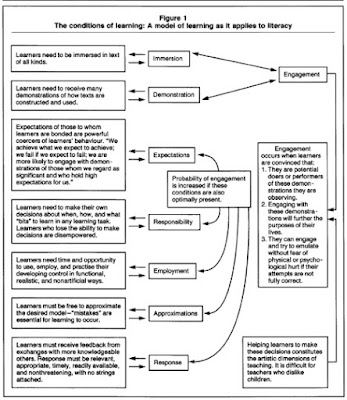I never teach my pupils; I only attempt to provide the conditions in which they can learn.Albert Einstein
In this exhibit, we explore the learning theory developed by Brian Cambourne from his research on language acquisition in natural settings. His book, The Whole Story: Natural Learning and the Acquisition of Literacy, first introduced the idea that certain conditions were necessary in order for us to learn language. These conditions were further explored in the article, Toward an educationally relevant theory of literacy learning: Twenty years of inquiry. In both the book and the article, Cambourne describes the eight Conditions of Learning in detail. Below is a figure from the article representing the relationships that exist between the Conditions.
 |
| From Toward an educationally relevant theory of literacy learning |
 |
| From Engaging Adolescent Learners |
How do the Conditions of Learning fit into your practice?



